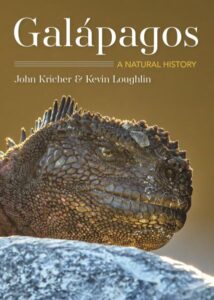 When it comes to writing a natural history guide to so iconic a location as the Galápagos Islands, an author is faced with something of a challenge. The number of total species is not particularly high, so a standard field guide treatment would yield a rather short book indeed, but the ecological significance and scientific history of the area is extraordinary, well worthy of multiple volumes; therefore adopting the ancient Delphic maxim of μηδὲν ἄγαν – nothing in excess – is clearly the best course of action.
When it comes to writing a natural history guide to so iconic a location as the Galápagos Islands, an author is faced with something of a challenge. The number of total species is not particularly high, so a standard field guide treatment would yield a rather short book indeed, but the ecological significance and scientific history of the area is extraordinary, well worthy of multiple volumes; therefore adopting the ancient Delphic maxim of μηδὲν ἄγαν – nothing in excess – is clearly the best course of action.
Back in 2006, Prof. John Kricher took just such an approach in the writing of his Galápagos: A Natural History, a book that quickly, and justifiably, became the essential reference guide to which those interested in the area most readily turned. Since that time, of course, much has been added to the knowledge about the islands and many taxonomies have been updated to reflect recent discoveries about its species, making an update to Prof. Kricher’s original book a worthy project indeed.
Thus just this past November, the new extensively updated volume Galápagos: A Natural History, Second Edition, was published by Princeton University Press. Joining Prof. Kricher as co-author of this new edition is acclaimed nature photographer and founder of Wildside Nature Tours Kevin Loughlin. Together, the duo has brought to eager naturalists a nearly five hundred page comprehensive and richly illustrated guidebook that both presents the natural history of the islands in a manner that is as applicable in the field as it is in the library.
Thematically composed chapters addressing the islands’ “geology, ecology, human history, Darwin’s finches and how Darwin came to his theory of natural selection from his visit to the islands, Galápagos tortoises, marine and land iguanas, mammals, seabirds, landbirds, marine life, and conservation challenges and initiatives” are all included, as is a section that presents information on each island individually with information about their respective endemic plant and animal species.
All who hold an interest in these remarkable islands are highly encouraged to look further into adding this new volume to their respective libraries, and anyone contemplating a trip there should consider it an essential addition to their pre-trip planning resources.
If you enjoyed reading this, please consider signing up for The Well-read Naturalist's newsletter. You'll receive a helpful list of recently published reviews, short essays, and notes about books in your e-mail inbox once each fortnight.
